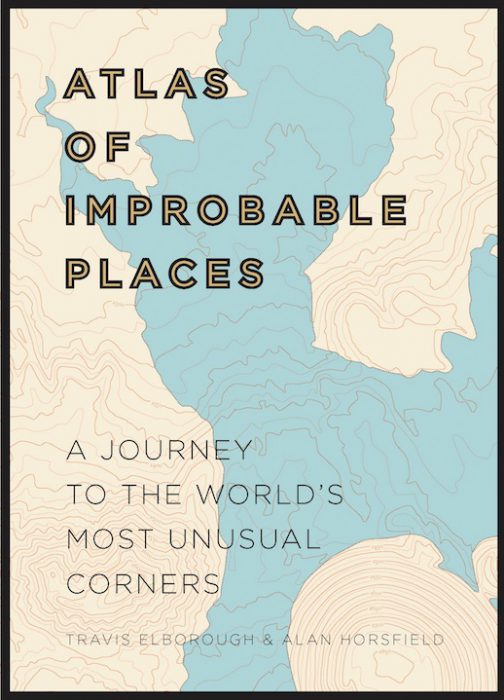Atlas of Improbable Places: A Journey to the World’s Most Unusual Corners by Travis Elborough & Martin Horsfield.
(Arum Press, hardback, 224 pages. Out now.)
Introduction by Travis Elborough
Maps, the great Italian writer Italo Calvino once maintained, presuppose the idea of a narrative as they are conceived on the basis of a journey, an odyssey. The earliest need to fix places on stone, skin or primitive paper was fundamentally linked to travel and the earliest cartographers looked to the sky rather than the earth for their starting points of reference. Today heavenly bodies, arguably, still guide us, as we take directions from GPS systems beaming information from satellites orbiting our planet. But the gulf between the age of the sextant and the wooden sailing ship, when so much of the world remained uncharted territory, and our satellite navigation-enabled present, seems impossibly vast.
To travel back then was often to embark on a journey into the unknown, with the final destination vague or the subject of wild speculation if not outright fiction, and one which the voyager might never reach let alone return from. We are, of course, the lucky beneficiaries of such sometimes suicidal pioneering expeditions. Places that were once the stuff of dreams and improbable to the point of implausibility are as accessible and now almost as familiar to us as our own neighbourhoods. Though that is not without its downsides entirely. Few of us believe the world is flat. But an hour or so on Google Maps or TripAdvisor surveying an increasingly interconnected and corporately globalized planet can definitely make us feel that it is flatter. Or at least rather less fantastical and strange than it was for our ancestors: a case of ‘here be dragons’ on the far corner of a sketchily drawn map giving way to ‘here be some well-known brands and chain shops’ flagged upon arrival on your phone’s app.
It was Calvino again who over forty years ago, in Invisible Cities, presciently invented a fictional metropolis called Trude whose overwhelming characteristic is that it is exactly the same as everywhere else. ‘If on arriving at Trude I had not read the city’s name written in big letters,’ the story’s narrator states, ‘I would have thought I was landing at the same airport from which I had taken off.’ At the end of the tale, his traveller, bored by Trude’s similarity with so many other places, begs to leave but is informed they will only ‘arrive at another Trude, absolutely the same, detail by detail. The world is covered by a sole Trude which does not begin and does not end. Only the name of the airport changes.’
But claims about the growing, soul-crushing similarity of places can be overstated, as hopefully this volume illustrates. Thankfully, the world continues to be a dizzyingly diverse place. Our appetite for the unusual and the out of the ordinary has, if anything, only been heightened by new technology, the scanning and sharing of fresh information and imagery themselves a spur to further travel and post-industrialization changing the kinds of places we find intriguing, beautiful or worthy of cursory investigation. When almost every action we perform online is tracked and all things digital attempt to distance us from the body and physical disintegration, it’s perhaps not so surprising that our fascination with the utterly abandoned, the long unobserved, the decayed and ruined has, for example, increased exponentially. That pictures of a weed-infested factory or decaying mansion in Detroit or St Louis, say, will frequently have their greatest currency on Instagram or other social media sites, only reaffirms rather than contradicts a particular contemporary desire to seek out the obscure and the unburnished.
The Atlas of Improbable Places, my collaboration with the cartographer Alan Horsfield and specially commissioned by the publisher Aurum, was intended as a compendium of unlikely, curious and plain odd locales. The improbability factor, if you will, of each of these places was that they were distinguished by some element of their architecture, natural geography or present or past state of being. Improbability may have been inherent at the beginning, or thrust upon them later or only accrued in recent times but these place all have stories to tell us. The map may not be the territory, just as written history is not the sum of any individual place. But ideally we need to read them both to reach a greater understanding of where we are and where we might be going.
*
